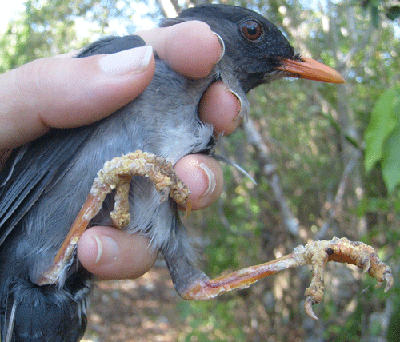 |
 |
Comments / Research Needs:
Sexing of adults by wing chord appears possible with WC < 117 = female; WC > 120 = male….but caution is urged until additional morphometric data are available from other populations across the island.
Primary10 (p10) is reduced.
The “richness” of the orange beak and “darkness” of the black tip may become more pronounced during breeding season (vs. dull orange and grey tip during non-breeding) :: more research is needed!
When Susan was assembling the data and photographs, we couldn’t believe how incompetent she was - - how was it possible that she didn’t have a single photograph of an adult WCTH?!? Then when she created the “Timing of Moult” chart, she thought “how is it possible that out of 77 adults, I only detected a trace of moult (10% on the head) for only ONE individual?!?” Ah ha! Look at the patterns of monthly captures (Figures below):
But where are the SY birds from April through August? Numbers definitely decline.
And where are the bulk of the AHY / ASY birds from May through October? A few appear to breed (7 CPs and 7 BPs detected in 5 years of banding) in the area and we certainly caught fledglings in JUV plumage…but the data suggest that there might seasonal movement to a different breeding area. Undoubtedly, radio-tagging a few individuals and tracking their movements would prove very interesting.
So by the time good numbers of AHY / ASY were back in the Windsor area (December through April), they were likely showing some feather wear…so I (Susan) never bothered to photograph them because I was always waiting for a “fresh and shiny, just-moulted adult”. Perhaps I should call them "Godot Birds".
Clearly more research is needed on the potential seasonal movements of this species.
| SCALY MITE ALERT: | |
| When we mist-net in coastal habitats, we occassionally encounter passerines (incl. Yellow-shouldered Grassquit, Greater Antillean Bullfinch, Orangequit,
Bananaquit) with “scaly mite” (Knemidocoptes spp.) on their legs (See also Blake 1957).
Intriguingly with our Windsor / northern Cockpit Country banding stations, White-chinned Thrush has been the only species for which we have ever detected this problem. Unfortunately, we never collected skin scrapings to have the mites identified taxonomically, but we rather suspect this might be a new species of mite which may be transmitted in the nest. |
 |
| Open call to arachnologists – if anyone wants to try and identify the mite species, we’ll apply to NEPA for collecting and export permits!
In light of the fact that 30 of the 206 (14%) WCTHs we handled showed signs of infestation (incl. two birds which appeared clean when 1st captured, but had scaly mite on recapture [bands removed], we now recommend using numbered, open plastic bands on WCTH in Cockpit Country. |
 |
| Even if a WCTH doesn’t show any signs of scaly mite, we also recommend always using a hand sanitizer after
handling this species and before handling any another bird. Of course, holding bags are never re-used on another bird until they (the bags!) are properly washed, but even at the banding station we make sure any bag used with a WCTH is placed in a separate plastic bag to make doubly-sure no one grabs it accidentally and uses it again. |
 |
 |
 |
Literature Cited
Blake, C.H. 1957. Diseases and injuries of Jamaican birds. Bird-Banding 28: 157-159.

